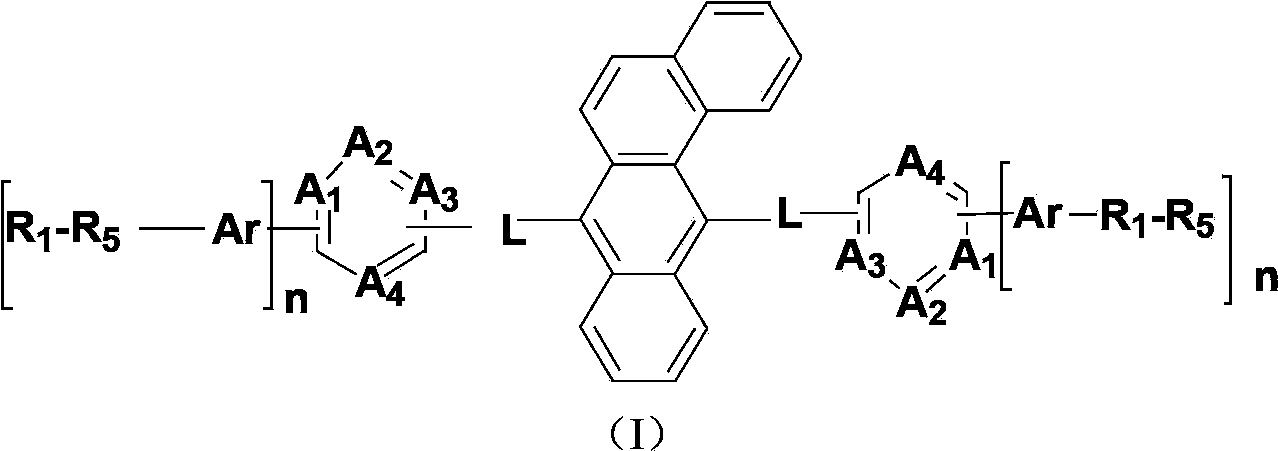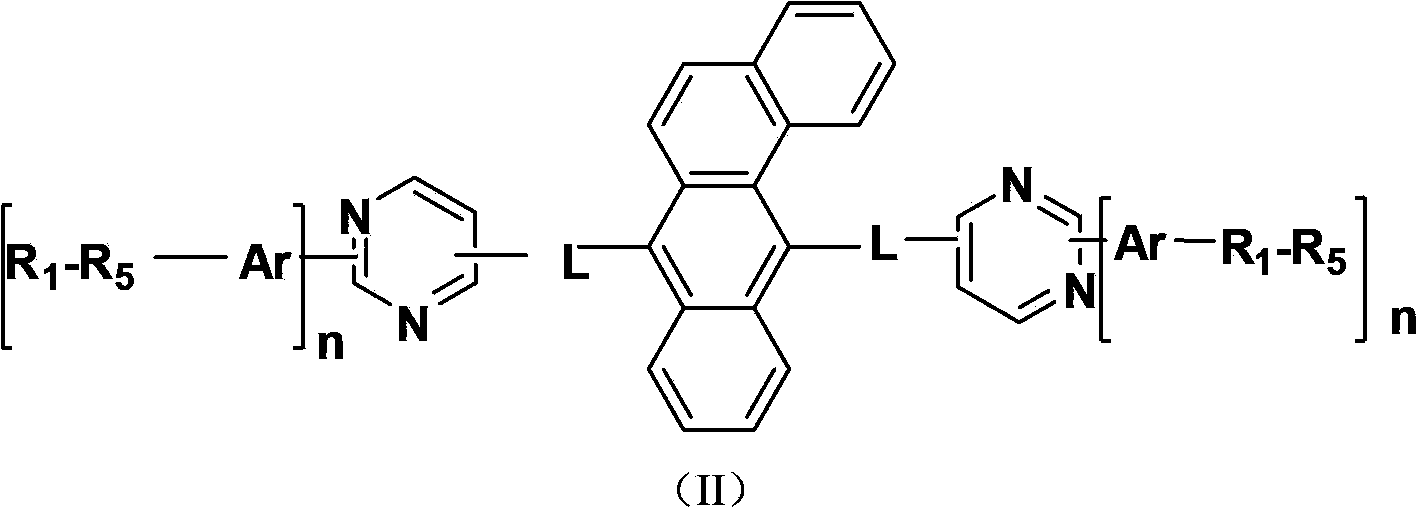Benzanthracene derivatives containing pyrimidinyl, pyrazinyl or triazinyl groups and applications thereof
A derivative, benzanthracene technology, applied in the field of new organic materials, can solve the problems of molecular formation crystallization and difficult film formation, and achieve the effects of increasing film formation, good film formation, and improving electron accepting ability and mobility.
- Summary
- Abstract
- Description
- Claims
- Application Information
AI Technical Summary
Problems solved by technology
Method used
Image
Examples
Embodiment 1
[0075] The synthesis of embodiment 1 compound 1
[0076] (1) The first step
[0077]
[0078] Under the protection of Ar gas, 18.2 g of 2,4,6-trichloropyrimidine (molecular weight 182, 0.10 mol), 14.2 g of benzanthracene-7,12-diboronic acid (molecular weight 316, 0.045 mol), tetrakis(triphenylphosphine) palladium 6.0g (0.0052mol), THF 600ml, toluene 400ml, potassium carbonate 60g (0.435mol) dissolved in 400ml water to form a solution into the reaction flask. After repeated ventilation under reduced pressure, start the electric stirring, monitor the reaction with TLC (thin layer chromatography), and the reaction is complete after refluxing for 5 hours. After cooling, the reaction system was divided into two layers. The organic layer was separated and evaporated to dryness to obtain a solid product, which was recrystallized with toluene to obtain 18.8 g of an intermediate with a molecular weight of 522 and a yield of 80%.
[0079] (2) The second step
[0080]
[0081] U...
Embodiment 2
[0083] The synthesis of embodiment 2 compound 2
[0084] (1) The first step
[0085]
[0086] Under the protection of Ar gas, 18.2 g of 2,4,6-trichloropyrimidine (molecular weight 182, 0.10 mol), 28.1 g of phenylboronic acid (molecular weight 122, 0.23 mol), tetrakis(triphenyl Phosphine) Palladium 12.0g (0.0104mol), 600ml of THF, 400ml of toluene, potassium carbonate 60g (0.435mol) dissolved in 400ml of water to form a solution into the reaction flask. After repeated ventilation under reduced pressure, start the electric stirring, monitor the reaction with TLC (thin layer chromatography), and the reaction is complete after reflux for 8 hours. After cooling, the reaction system was divided into two layers. The organic layer was separated and evaporated to dryness to obtain a solid product, which was recrystallized with toluene to obtain 19.9 g of an intermediate with a molecular weight of 266 and a yield of 75%.
[0087] (2) The second step
[0088]
[0089] Under the ...
Embodiment 3
[0091] The synthesis of embodiment 3 compound 3
[0092] (1) The first step
[0093]
[0094] Under the protection of Ar gas, carbazole 16.7g (molecular weight 167, 0.1mol) was dissolved in anhydrous DMF 180ml, a solution of 5.64g NaH (content 55%, 0.235mol) in 180ml DMF was added dropwise for 20min, stirred for 1h, and then 18.2g of 2,4,6-trichloropyrimidine (molecular weight 182, 0.1mol) dissolved in 180ml of DMF was added in 20min, stirred for 3h, poured into 1000ml of water, filtered and dried in vacuo, the product was purified by silica gel column, 25.4 g of the target molecule (0.081 mol) was obtained with a molecular weight of 313 and a yield of 81%.
[0095] (2) The second step
[0096]
[0097] Under the protection of Ar gas, add 15.6g of the reaction product of the previous step (molecular weight 313, 0.05mol), 6.71g of phenylboronic acid (molecular weight 122, 0.055mol), tetrakis (triphenylphosphine) palladium 3.0 g (0.0026mol), 150ml of THF, 100ml of tolue...
PUM
 Login to View More
Login to View More Abstract
Description
Claims
Application Information
 Login to View More
Login to View More - R&D
- Intellectual Property
- Life Sciences
- Materials
- Tech Scout
- Unparalleled Data Quality
- Higher Quality Content
- 60% Fewer Hallucinations
Browse by: Latest US Patents, China's latest patents, Technical Efficacy Thesaurus, Application Domain, Technology Topic, Popular Technical Reports.
© 2025 PatSnap. All rights reserved.Legal|Privacy policy|Modern Slavery Act Transparency Statement|Sitemap|About US| Contact US: help@patsnap.com



